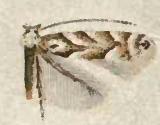
Gracillariidae is an important family of insects in the order Lepidoptera and the principal family of leaf miners that includes several economic, horticultural or recently invasive pest species such as the horse-chestnut leaf miner, Cameraria ohridella.

Phyllonorycter froelichiella is a moth of the family Gracillariidae. It is found in all of Europe, except Greece.
Phyllonorycter anderidae is a moth of the family Gracillariidae. The species was first described by W. H. B. Fletcher in 1885. It is found from Fennoscandia and northern Russia to Belgium, Austria and Ukraine and from Great Britain to southern Russia.

Phyllonorycter salicifoliella is a moth of the family Gracillariidae. It is widespread across North America, from Mississippi to Ontario in the east and from southern California to northern British Columbia in the west.

Calybites phasianipennella is a moth of the family Gracillariidae. It is known from all of Europe and most of Asia.
Calybites quadrisignella is a moth of the family Gracillariidae. It is found in Central and Eastern Europe.

Acrocercops chionosema is a moth of the family Gracillariidae. It is known from Queensland and New South Wales, Australia.
Calybites lepidella is a moth of the family Gracillariidae. It is known from New South Wales, Australia.
Porphyrosela teramni is a moth of the family Gracillariidae. It is known from South Africa and Zimbabwe.
Eumetriochroa miyatai is a moth of the family Gracillariidae. It is known from the islands of Hokkaidō, Honshū, Shikoku and Kyūshū in Japan.
Metriochroa fraxinella is a moth of the family Gracillariidae. It is known from Japan.
Gracillaria japonica is a moth of the family Gracillariidae. It is known from the island of Honshu, the main island of Japan.
Gracillaria ussuriella is a moth of the family Gracillariidae. It is known from the islands of Hokkaidō, Honshū and Kyūshū in Japan and the Russian Far East.
Calybites trimaculata is a moth of the family Gracillariidae. It is known from Japan.
Cameraria lobatiella is a moth of the family Gracillariidae. It is known from British Columbia in Canada, and California in the United States.
Cameraria macrocarpae is a moth of the family Gracillariidae. It is only known from Manitoba, Canada.
Calybites securinella is a moth of the family Gracillariidae. It is known from the Russian Far East. and Korea.
The western tentiform leafminer is a moth of the family Gracillariidae. It is known from British Columbia in Canada and California, Oregon, Washington and Utah in the United States.
Liocrobyla paraschista is a moth of the family Gracillariidae. It is known from Fiji, India and Japan and Korea.
Caloptilia fraxinella is a moth of the family Gracillariidae. It is known from Canada and the United States.



